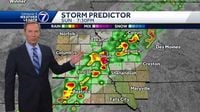Residents of Omaha, Nebraska, braced themselves on Sunday evening, October 5, 2025, as a series of thunderstorms rolled into the city, bringing with them the threat of gusty winds, hail, and a dramatic drop in temperatures. According to local meteorologists and reports from both KETV and WOWT, the unsettled weather was expected to linger through the night and into the first half of Monday, prompting many to adjust their plans and keep a close eye on the sky.
The day began with a high of 83 degrees—twelve degrees above the seasonal average—making it feel more like late summer than early October. But by late afternoon, the weather had already begun to shift. "Showers and thunderstorms are popping up now, moving across the metro and giving us some rainfall. And looks like we’ll be with us for much of the evening tonight, and also for at least the first half of tomorrow," a KETV meteorologist explained during the evening broadcast. The message was clear: outdoor plans would be best postponed.
As the clock neared 5:00 PM, scattered thundershowers began to develop, particularly south of Interstate 80. According to WOWT, these storms were expected to continue through the night, with the most intense activity likely occurring between 5:00 and 6:00 PM. While the severe weather risk was classified as low, the National Weather Service issued a Level 1 Marginal risk for areas mainly south of the metro, highlighting the potential for damaging winds exceeding 60 miles per hour and hailstones the size of quarters. "We may get a brief wind gust 50–60 miles an hour, possibly get a hailstone half an inch, maybe some isolated one inch," KETV noted, emphasizing the unpredictable nature of these pop-up storms.
Despite the marginal risk, forecasters did not anticipate issuing a widespread severe weather watch. The main threats remained isolated: strong wind gusts, brief downpours, and localized hail. Rainfall totals, however, could be significant in some pockets. "If you get hit by a couple of these thunderstorms, you could get over an inch. This has got almost two in Nebraska City," KETV reported, underscoring the variability that often accompanies thunderstorm activity in the region.
As the evening progressed, radar images showed storm cells moving east and south, with some of the heaviest rain skirting the metro area. By 10:00 PM, the storms were expected to shift, but another round was forecast for the overnight hours. The cold front responsible for the stormy weather was already making its presence felt, with winds beginning to shift from the southwest to the north. "That’s now through Fremont, through Columbus, through Norfolk, through York. And it’s what the storms are developing on at the moment. You can see it right there. Scattered thunderstorm activity, somewhat more unstable air to the southeast, better chance of showers and storms, much cooler air," the KETV meteorologist explained.
Monday, October 6, promised to be a stark contrast to the previous day’s warmth. The high temperature was expected to occur just after midnight, hovering in the mid-60s, before dropping steadily into the lower 50s as the day wore on. "Because of the timing of the cold front, Monday’s high will occur around midnight early Monday in the mid 60s. During the day, temperatures will remain consistent in the lower 50s," WOWT reported. Showers and thunderstorms were forecast to persist through the morning, accompanied by persistent cloud cover and breezy conditions, with north winds gusting up to 30 miles per hour. For those hoping for a quick end to the rain, patience would be required; another chance for scattered showers was possible late Monday, though forecasters said the likelihood was low. The rain was expected to clear completely by midnight Tuesday morning.
The sudden change in temperature—dropping from the low 80s on Sunday to the low 50s on Monday—was a reminder of just how quickly fall can assert itself in the Midwest. "There’s a huge change in the temperatures coming tonight, as that southwest wind is replaced by a north wind," KETV warned. For some, the cooler weather was a welcome relief. "That’s beautiful fall weather on the way for Tuesday and Wednesday. Lows in the 40s. Highs upper 60s to near 70," the KETV meteorologist added, noting that the city would enjoy a brief period of classic autumn conditions before temperatures began to rebound later in the week.
Tuesday, October 7, was forecast to be mostly sunny and cool, with highs in the upper 60s. But the cool spell would be short-lived. By Wednesday and into the latter half of the workweek, temperatures were expected to climb back toward 80 degrees, offering yet another taste of late-season warmth. "It will be short-lived, however, as we will see more chances of spotty showers and warming back to near 80 degrees by the back half of our upcoming work week," WOWT predicted, suggesting that Omaha’s weather would continue its unpredictable dance between summer and fall.
For those tracking rainfall totals, the storms posed an interesting challenge. While some areas north of the metro, such as Tekamah, Columbus, and Norfolk, were expected to see little precipitation, other locations could see totals exceeding an inch, particularly where thunderstorms lingered. Nebraska City, for example, was on track to receive nearly two inches, highlighting the hyper-local nature of thunderstorm rainfall.
Despite the inconvenience of rain and the possibility of isolated severe weather, officials and meteorologists emphasized that the overall threat remained low. No widespread severe weather watch was issued, and the main concerns centered on localized wind and hail. "No widespread severe weather, but maybe something very isolated," KETV summarized, providing reassurance even as the city hunkered down for a wet and windy night.
As Omaha residents looked ahead to the rest of the week, the forecast offered a bit of everything: storms, a dramatic cooldown, a taste of fall, and then a return to warmth. For those who love variety, it was a forecast that had it all. And for everyone else, it was a reminder to keep an umbrella—and maybe a jacket—close at hand.
By the time the rain clears and the sun returns, Omaha will have weathered another classic Midwestern transition, where summer and fall collide in spectacular fashion, and the only certainty is that change is always just around the corner.




